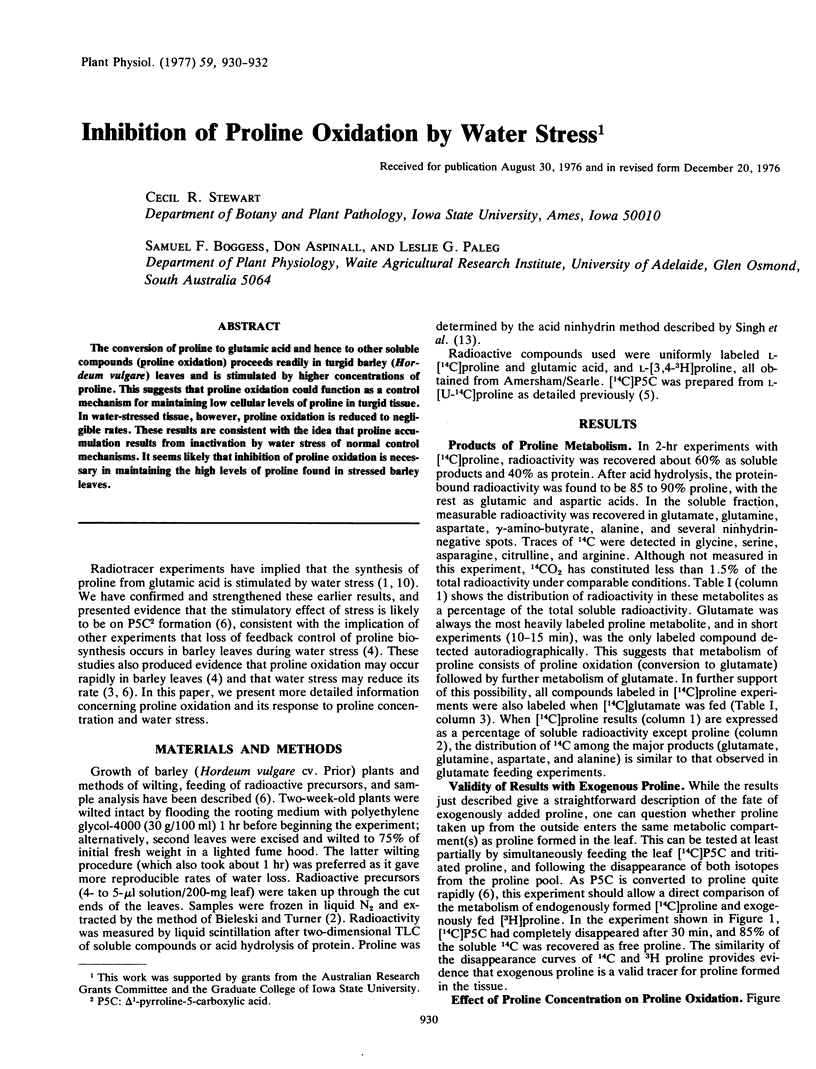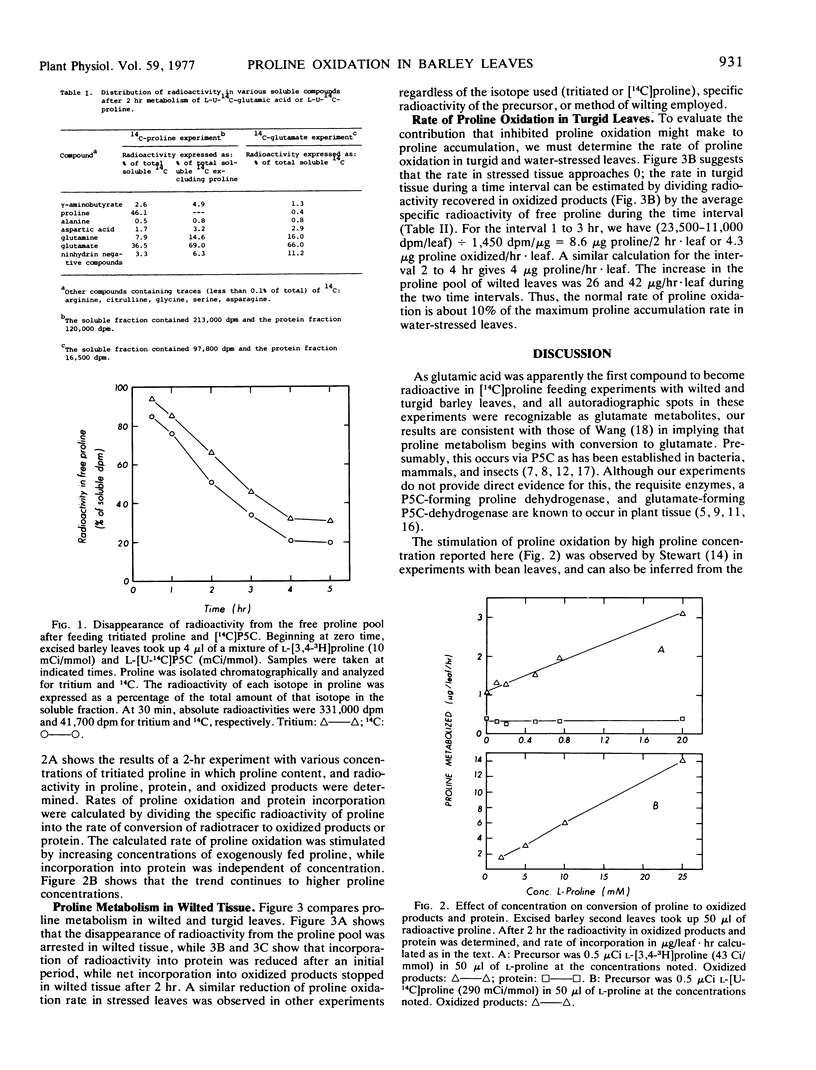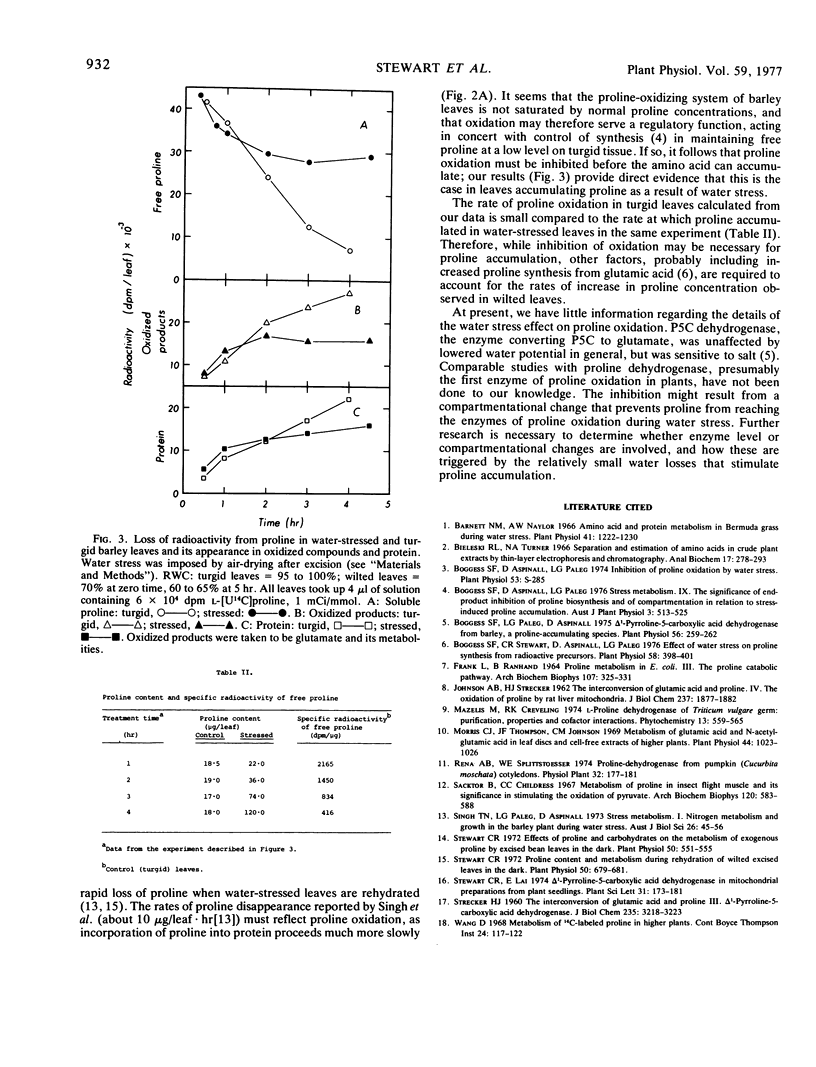Abstract
The conversion of proline to glutamic acid and hence to other soluble compounds (proline oxidation) proceeds readily in turgid barley (Hordeum vulgare) leaves and is stimulated by higher concentrations of proline. This suggests that proline oxidation could function as a control mechanism for maintaining low cellular levels of proline in turgid tissue. In water-stressed tissue, however, proline oxidation is reduced to negligible rates. These results are consistent with the idea that proline accumulation results from inactivation by water stress of normal control mechanisms. It seems likely that inhibition of proline oxidation is necessary in maintaining the high levels of proline found in stressed barley leaves.
Full text
PDF


Selected References
These references are in PubMed. This may not be the complete list of references from this article.
- Barnett N. M., Naylor A. W. Amino Acid and protein metabolism in bermuda grass during water stress. Plant Physiol. 1966 Sep;41(7):1222–1230. doi: 10.1104/pp.41.7.1222. [DOI] [PMC free article] [PubMed] [Google Scholar]
- Bieleski R. L., Turner N. A. Separation and estimation of amino acids in crude plant extracts by thin-layer electrophoresis and chromatography. Anal Biochem. 1966 Nov;17(2):278–293. doi: 10.1016/0003-2697(66)90206-5. [DOI] [PubMed] [Google Scholar]
- Boggess S. F., Paleg L. G., Aspinall D. Delta-Pyrroline-5-carboxylic Acid Dehydrogenase in Barley, a Proline-accumulating Species. Plant Physiol. 1975 Aug;56(2):259–262. doi: 10.1104/pp.56.2.259. [DOI] [PMC free article] [PubMed] [Google Scholar]
- Boggess S. F., Stewart C. R. Effect of water stress on proline synthesis from radioactive precursors. Plant Physiol. 1976 Sep;58(3):398–401. doi: 10.1104/pp.58.3.398. [DOI] [PMC free article] [PubMed] [Google Scholar]
- Ecklund P. R., Moore T. C. Correlations of Growth Rate and De-etiolation with Rate of Ent-Kaurene Biosynthesis in Pea (Pisum sativum L.). Plant Physiol. 1974 Jan;53(1):5–10. doi: 10.1104/pp.53.1.5. [DOI] [PMC free article] [PubMed] [Google Scholar]
- FRANK L., RANHAND B. PROLINE METABOLISM IN ESCHERICHIA COLI. 3. THE PROLINE CATABOLIC PATHWAY. Arch Biochem Biophys. 1964 Aug;107:325–331. doi: 10.1016/0003-9861(64)90338-8. [DOI] [PubMed] [Google Scholar]
- JOHNSON A. B., STRECKER H. J. The interconversion of glutamic acid and proline. IV. The oxidation of proline by rat liver mitochondria. J Biol Chem. 1962 Jun;237:1876–1882. [PubMed] [Google Scholar]
- Morris C. J., Thompson J. F., Johnson C. M. Metabolism of Glutamic Acid and N-Acetylglutamic Acid in Leaf Discs and Cell-free Extracts of Higher Plants. Plant Physiol. 1969 Jul;44(7):1023–1026. doi: 10.1104/pp.44.7.1023. [DOI] [PMC free article] [PubMed] [Google Scholar]
- Stewart C. R. Effects of proline and carbohydrates on the metabolism of exogenous proline by excised bean leaves in the dark. Plant Physiol. 1972 Nov;50(5):551–555. doi: 10.1104/pp.50.5.551. [DOI] [PMC free article] [PubMed] [Google Scholar]
- Stewart C. R. Proline Content and Metabolism during Rehydration of Wilted Excised Leaves in the Dark. Plant Physiol. 1972 Dec;50(6):679–681. doi: 10.1104/pp.50.6.679. [DOI] [PMC free article] [PubMed] [Google Scholar]


